| Exit Print View | |
Sun Installation Assistant 2.3 through 2.4 User's Guide for x64 Servers |

|
About This Documentation (PDF and HTML)
Shell Prompts in Command Examples
Introduction to Sun Installation Assistant
Getting Started With Sun Installation Assistant
SIA Version 2.3 Through 2.4 Features and Benefits
Supported Servers and SIA Media Availability
Starting SIA and Preparing for Deployment or Recovery Tasks
Local and Remote Media Options
How to Create a RAID Volume Using SIA
How to Delete a RAID Volume Using SIA
How to Install Windows With SIA Using Local or Remote Media
How to Install Linux With SIA Using Local or Remote Media
Using SIA to Upgrade System Firmware
How to Upgrade the System BIOS and ILOM Firmware
How to Upgrade Expander Firmware
Using SIA to Recover a Service Processor
How to Recover a Service Processor
Performing an SIA PXE-Based Attended Installation
Obtain the SIA PXE Image Files
How to Create the SIA Image and Prepare for PXE Boot
How to Boot SIA From a PXE Server for an Attended Installation
Performing an SIA PXE-Based Unattended Installation
Obtain the SIA PXE Image Files
Contents of the SIA State File
How to Prepare for an Unattended SIA Installation of Linux
How to Prepare for an Unattended SIA Installation of Windows Server
How to Prepare for an Unattended SIA Firmware Upgrade
How to Create the SIA Image and Prepare for PXE Boot
How to Boot SIA From a PXE Server and Perform an Unattended Installation
Observing an SIA PXE-Based Unattended Installation
Set Up Passwords for Root and Virtual Access
Using a Virtual Console or Secure Shell (SSH) Connection
Debugging Unattended Installation Problems
Creating a Bootable SIA USB Flash Drive
Setting BIOS Parameters and Booting Off the SIA USB Flash Drive
Identifying a Linux Boot Device on a Sun Fire X4500 Server
How to Identify a Linux Boot Device on a Sun Fire X4500 Server
How to Install Service Tags in Linux
This section guides you through the initial steps of identifying the system hardware, setting up network access, updating SIA software, and preparing you for a deployment task (such as assisted operating system installation or system firmware upgrade) or recovery task (such as service processor recovery).
Note - In the instructions that follow, example dialog screen shots have been provided as a reference. Information displayed in each dialog may differ depending on your server model.
Start SIA using one of the supported methods:
Locally using a CD/DVD: Insert the SIA CD/DVD into the server’s CD/DVD drive and power on or reboot the server.
Locally using a USB flash drive: Plug the USB flash drive prepared with SIA software directly into one of the server’s USB ports. Redirect the server to boot from the USB flash drive as described in ![]() Creating a Bootable SIA USB Flash Drive.
Creating a Bootable SIA USB Flash Drive.
Remotely from a CD/DVD or image file: Log in to the server’s service processor from a remote console (or KVMS) using its ILOM (Integrated Lights Out Manager) interface and use the Remote Control Launch Redirection feature to redirect the server to the virtual CD/DVD-ROM that contains the SIA CD/DVD image. Then, reboot the server and direct it to boot from your virtual CD/DVD-ROM (typically done using the F8 menu available during server boot).
Note - Starting SIA from a redirected CD/DVD or ISO media can take up to several minutes. During that time the Launching SIA screen displays with a progress indicator.
Remotely using a PXE-based image: If you are using PXE network booting to load the Sun Installation Assistant image from a Linux-based PXE server, proceed to ![]() Performing an SIA PXE-Based Attended Installation.
Performing an SIA PXE-Based Attended Installation.
Note - The instructions below assume local CD/DVD drive access. Be sure to modify the instructions accordingly if you are using a local USB flash drive prepared with SIA software, or if you are running SIA from a remote console (or KVMS) with CD-ROM redirection.
As SIA starts, you will see various start up messages and then the Select Your Keyboard Language page appears.
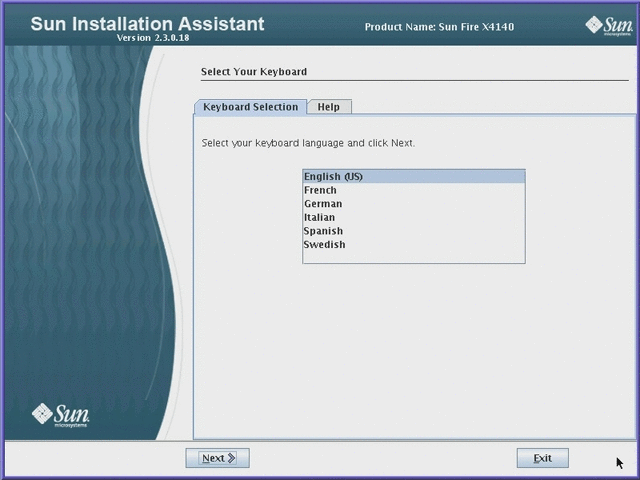
In the Select Your Keyboard Language, view the list of supported keyboards, select the language of the keyboard you are using, and then click Next.
The Software License Agreement page appears.
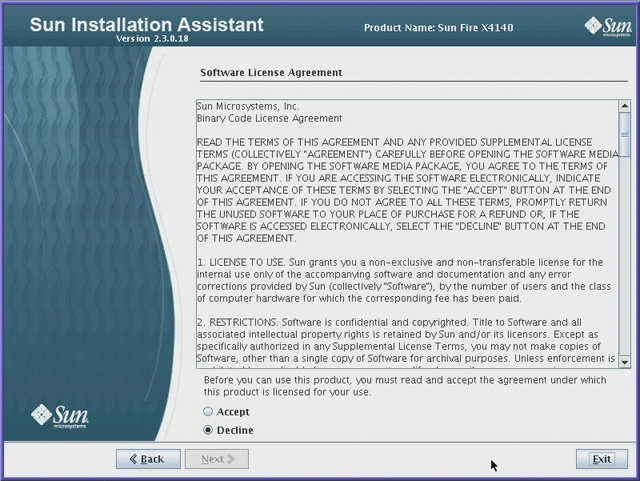
In the Software License Agreement page, click Accept to accept the license agreement, and then click Next.
The SIA Welcome page appears describing the available tasks that can be performed.

Note - Not all servers support all tasks. The tasks available to you are server-dependant.
In the SIA Welcome page, click the Release Notes tab to check for important information about this version of SIA. When done, click Next.
The SIA Update page appears.
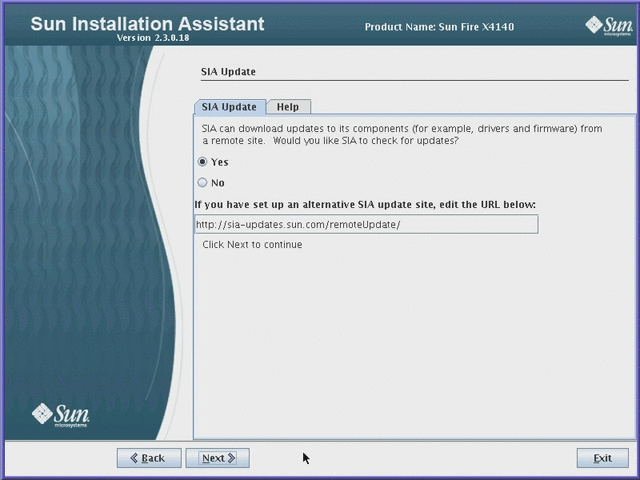
In the SIA Update page, select Yes to download the latest software updates from Oracle for the current session of SIA, and then click Next.
SIA Update from the Oracle site requires that your server have Internet access (typically through a proxy server). If you opt not to perform an update, SIA will use firmware and drivers available with the booted SIA image.
Note - The use of an alternate SIA update site is currently unsupported.
If you selected Yes to perform an update of the current SIA session, the Configure Active Network Connection page is displayed.
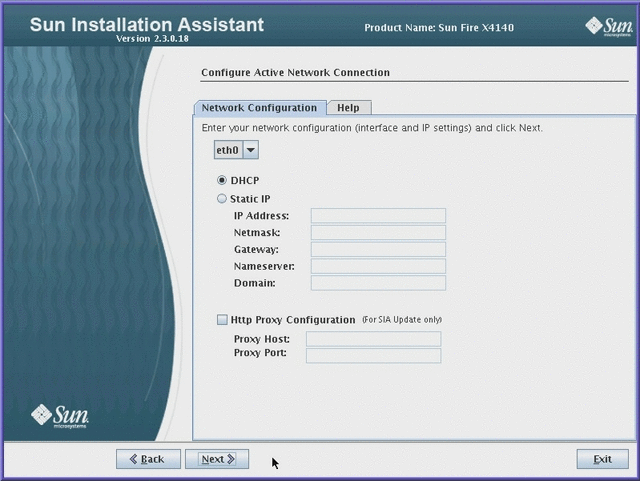
Do the following:
Select the active network interface on your server (for example: eth0).
This will enable the network interface used to access the update image. If your server has multiple network cards, be sure to use the network-connected interface that enables access to the host where the update image files reside (Internet access is required if you are using Oracle's SIA update site).
Select the network interface configuration method (DHCP or Static IP).
If static method is selected, provide the necessary information (for example, your server’s IP address, netmask address, gateway address, and so on).
Provide proxy information if an HTTP proxy is needed for Internet access (proxy host and port for client connections), for example:
Proxy Host: webproxy.mycompany.com
Proxy Port: 8088
Click Next to establish a connection to the SIA Update site.
The update process checks for updates to SIA components. If updates are available the update components are listed.
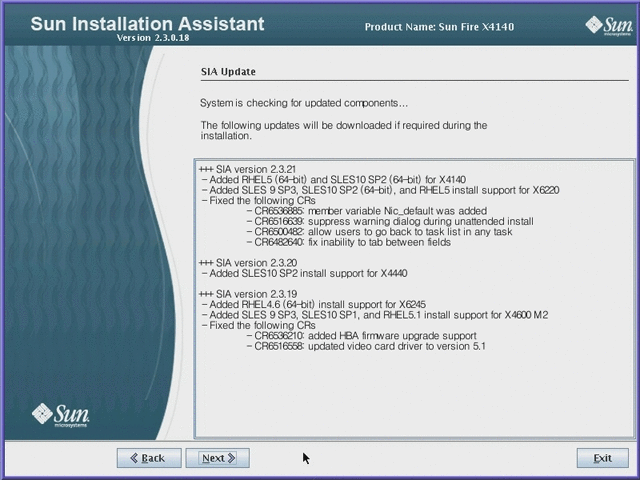
Click Next to proceed with the update.
When done, the System Information page appears.
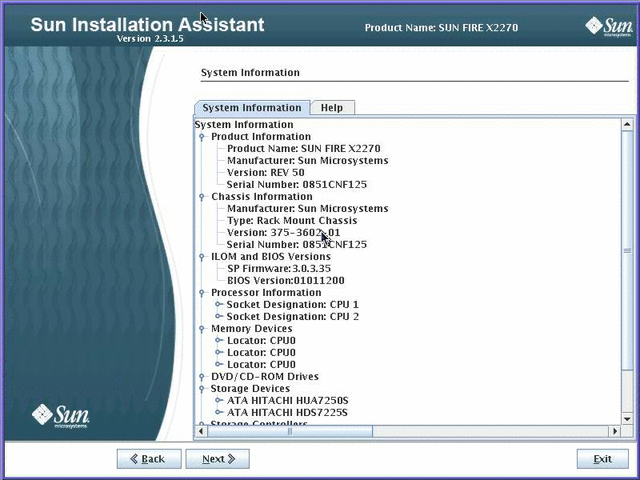
In the System Information page you can click the expand/collapse icon for any hardware component listed for more information about it. Explore components as desired, and click Next when done.
The Select a Task page appears.
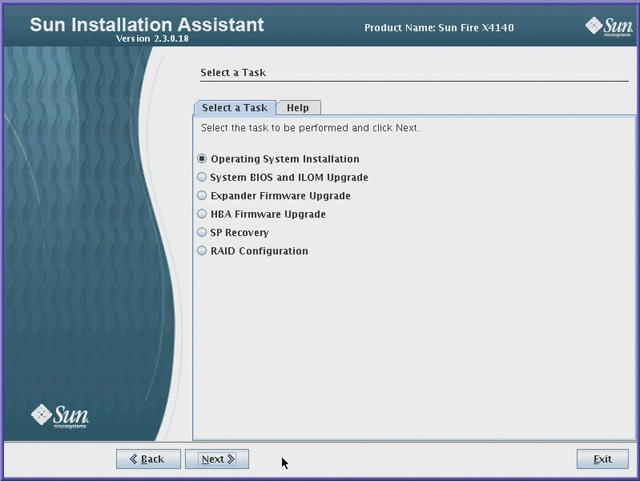
Note - The Task Selection dialog will only appear if your server supports more SIA tasks than OS installation. If it does not, SIA will proceed to OS installation.
In the Select a Task page, choose a deployment or recovery task to perform.
Note - Only task options supported for your server are listed. For example, your list may include operating system installation, server BIOS and ILOM upgrade, or other tasks.
Refer to the appropriate section listed below for task–related information.
If you plan on including your operating system boot disk as part of a RAID configuration and your server has an LSI-based disk controller, proceed to ![]() Configuring RAID.
Configuring RAID.
If you need to install a supported operating system for your server, proceed to ![]() Installing Windows With SIA or
Installing Windows With SIA or ![]() Installing Linux With SIA.
Installing Linux With SIA.
If you need to upgrade system firmware (BIOS/ILOM, HBA or disk expander), proceed to ![]() Using SIA to Upgrade System Firmware.
Using SIA to Upgrade System Firmware.
If you need to recover from a corrupt or inaccessible ILOM service processor, proceed to ![]() Using SIA to Recover a Service Processor.
Using SIA to Recover a Service Processor.